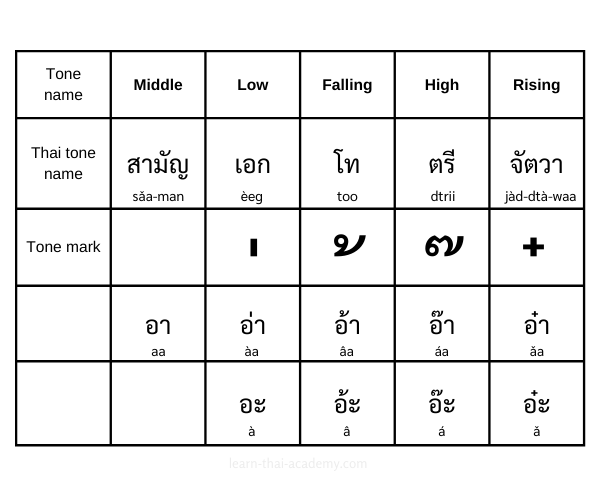Your cart is currently empty!

Mastering Thai Tones: A Comprehensive Guide for Language Learners
Introduction
Welcome to your new journey of mastering the Thai language! In this detailed guide, we will introduce you to the unique tonal system of Thai language, helping you understand and practice each tone effectively. Let’s embark on this exciting learning adventure together.
Understanding the Tone Chart
There are five tones in Thai, and similar words with different tones can convey entirely different meanings. The chart below will help you understand the different pronunciations for each tone in Thai. Practicing these tones is essential for clear and effective communication in Thai, and we’re here to guide you every step of the way. The representative pronunciation for each tone is included at the end of this page.
Tone Descriptions:
- Mid Tone (เสียงสามัญ – sǐiang sǎa-man): Spoken in a constant pitch. It neither rises nor falls.
- Falling Tone (เสียงโท – sǐiang too): Lower your pitch suddenly, as if your voice is dropping.
- High Tone (เสียงตรี – sǐiang trii): Raise your pitch suddenly, like a quick jump in your voice.
- Rising Tone (เสียงจัตวา – sǐiang jàd-dtà-waa): Raise your pitch slowly and steadily.

Detailed Breakdown of Thai Tones
The Thai language consists of five tones, which Thai people call:
- เสียงสามัญ (sǐiang sǎa-man): The word เสียง (sǐiang) means “voice” and สามัญ (sǎa-man) means “common” or “ordinary.” This tone is referred to as the middle tone, with a steady pitch. For example, the sound “อ”.
- เสียงเอก (sǐiang èeg): Lower pitch, similar to how you would slowly drop your voice.
- เสียงโท (sǐiang too): A sudden drop in pitch.
- เสียงตรี (sǐiang trii): A sudden rise in pitch.
- เสียงจัตวา (sǐiang jàd-dtà-waa): A gradual rise in pitch.
In Thai, the words เอก (èeg), โท (too), ตรี (trii), and จัตวา (jàd-dtà-waa) are fancy terms for one, two, three, and four, respectively. This is akin to how we use mono, di, tri, and tetra in English words.
Tone Marks (วรรณยุกต์ – wan-na-yúg) in Thai
In Thai, we have symbols called วรรณยุกต์ (wan-ná-yúk) to indicate the tone. These are:
- ไม้เอก (mái èeg): Indicates the low tone.
- ไม้โท (mái too): Indicates the falling tone.
- ไม้ตรี (mái trii): Indicates the high tone.
- ไม้จัตวา (mái jàd-dtà-waa): Indicates the rising tone.
However, there are exceptions where the mark and the actual tone of the words may not match. For example, short vowels like อะ are pronounced “à” in the low tone even though there is no tone mark on Thai script.

Practice with Audio
On this page, we provide audio recordings for each tone with long and short vowels. Listen to each tone to become more familiar with the Thai language. By practicing these tones, you will improve your pronunciation and communication skills in Thai.
Enjoy your Thai learning journey!
Long vowels (aa)
Middle tone
Low tone
Falling tone
High tone
Rising tone
Short vowels (a)
Middle tone
[nonexistent]
